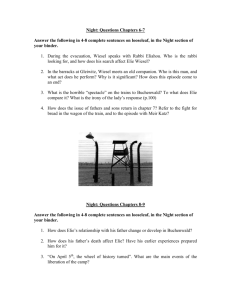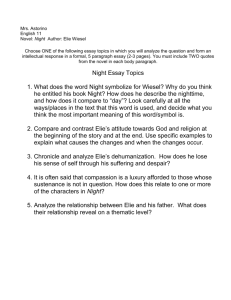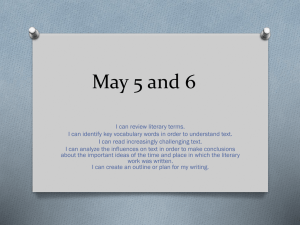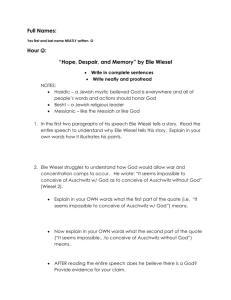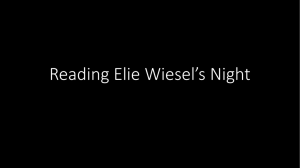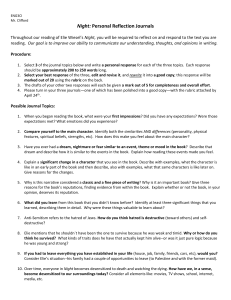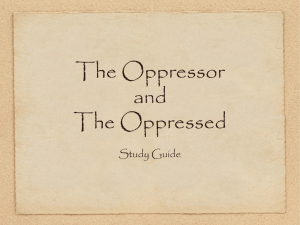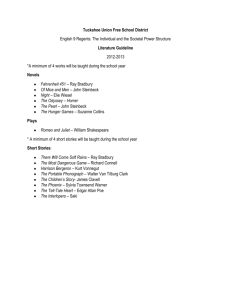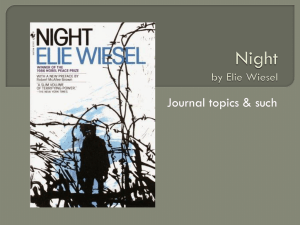Night study guide File - Galena Park ISD Moodle
advertisement
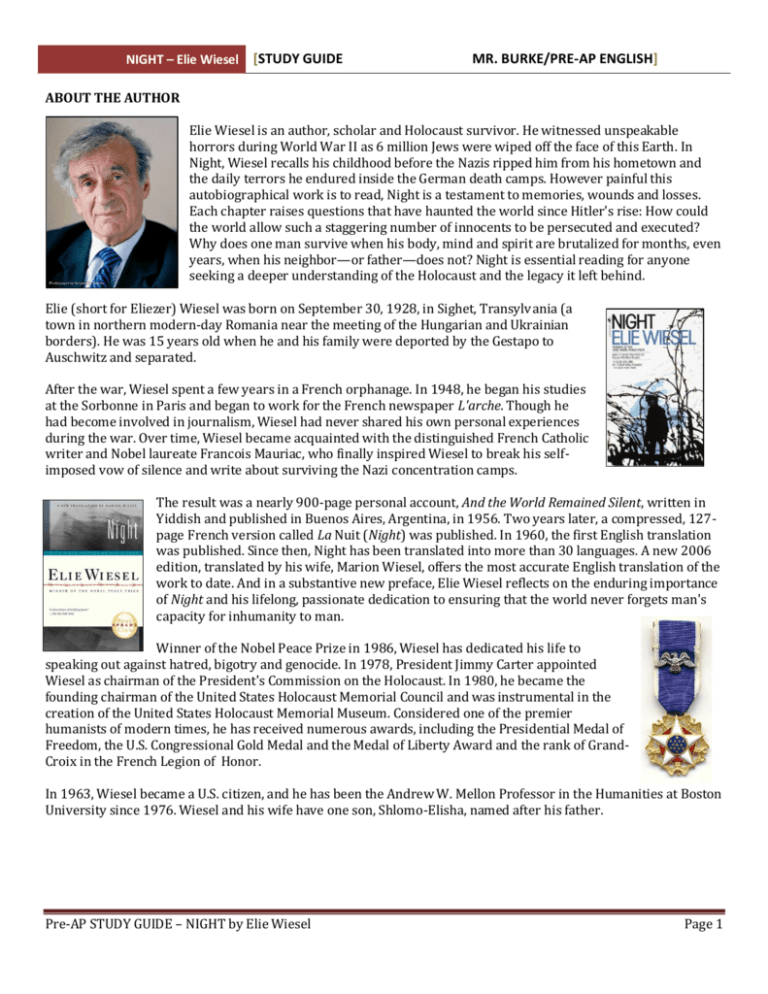
NIGHT – Elie Wiesel [STUDY GUIDE MR. BURKE/PRE-AP ENGLISH] ABOUT THE AUTHOR Elie Wiesel is an author, scholar and Holocaust survivor. He witnessed unspeakable horrors during World War II as 6 million Jews were wiped off the face of this Earth. In Night, Wiesel recalls his childhood before the Nazis ripped him from his hometown and the daily terrors he endured inside the German death camps. However painful this autobiographical work is to read, Night is a testament to memories, wounds and losses. Each chapter raises questions that have haunted the world since Hitler's rise: How could the world allow such a staggering number of innocents to be persecuted and executed? Why does one man survive when his body, mind and spirit are brutalized for months, even years, when his neighbor—or father—does not? Night is essential reading for anyone seeking a deeper understanding of the Holocaust and the legacy it left behind. Elie (short for Eliezer) Wiesel was born on September 30, 1928, in Sighet, Transylvania (a town in northern modern-day Romania near the meeting of the Hungarian and Ukrainian borders). He was 15 years old when he and his family were deported by the Gestapo to Auschwitz and separated. After the war, Wiesel spent a few years in a French orphanage. In 1948, he began his studies at the Sorbonne in Paris and began to work for the French newspaper L'arche. Though he had become involved in journalism, Wiesel had never shared his own personal experiences during the war. Over time, Wiesel became acquainted with the distinguished French Catholic writer and Nobel laureate Francois Mauriac, who finally inspired Wiesel to break his selfimposed vow of silence and write about surviving the Nazi concentration camps. The result was a nearly 900-page personal account, And the World Remained Silent, written in Yiddish and published in Buenos Aires, Argentina, in 1956. Two years later, a compressed, 127page French version called La Nuit (Night) was published. In 1960, the first English translation was published. Since then, Night has been translated into more than 30 languages. A new 2006 edition, translated by his wife, Marion Wiesel, offers the most accurate English translation of the work to date. And in a substantive new preface, Elie Wiesel reflects on the enduring importance of Night and his lifelong, passionate dedication to ensuring that the world never forgets man's capacity for inhumanity to man. Winner of the Nobel Peace Prize in 1986, Wiesel has dedicated his life to speaking out against hatred, bigotry and genocide. In 1978, President Jimmy Carter appointed Wiesel as chairman of the President's Commission on the Holocaust. In 1980, he became the founding chairman of the United States Holocaust Memorial Council and was instrumental in the creation of the United States Holocaust Memorial Museum. Considered one of the premier humanists of modern times, he has received numerous awards, including the Presidential Medal of Freedom, the U.S. Congressional Gold Medal and the Medal of Liberty Award and the rank of GrandCroix in the French Legion of Honor. In 1963, Wiesel became a U.S. citizen, and he has been the Andrew W. Mellon Professor in the Humanities at Boston University since 1976. Wiesel and his wife have one son, Shlomo-Elisha, named after his father. Pre-AP STUDY GUIDE – NIGHT by Elie Wiesel Page 1 NIGHT – Elie Wiesel [STUDY GUIDE MR. BURKE/PRE-AP ENGLISH] INDIVIDUALS (in order of appearance) Eliezer (Elie) Wiesel, the narrator, twelve when the book opens in 1941; deported in the spring of 1944 to Auschwitz, where he and his father are separated from his mother and sisters. Elie had been drawn to Jewish mysticism, but the horrors of life under the Nazis weaken his faith. Moishe the Beadle, a poor “man of all work” in the Hasidic synagogue of Sighet; Wiesel’s instructor in Jewish mystical lore; survivor of an early deportation whose story is not believed. Chlomo Wiesel,Wiesel’s father, a shopkeeper of Sighet who suffers through nearly a year of nightmarish captivity in Nazi concentration camps before dying in Buchenwald in January 1945. Mrs. Wiesel, Hilda, Béa, and Tzipora, Wiesel’s mother, two older sisters, and baby sister. Elie does not learn until after the war that only Hilda and Béa survived. Madame Schächter, a guest of Wiesel’s house who was transported without her husband. Stein of Antwerp, a distant relative of the Wiesels, whom Wiesel and his father encounter at Auschwitz. Akiba Drumer, a camp inmate; a mystic who believes that God must be testing the Jews through the Holocaust. Juliek, Polish violinist whom Wiesel meets at Buna; he dies during the forced evacuation to Buchenwald. Idek, a Kapo who beats Elie severely. Franek, Eliezer’s foreman at Buna. Yossi and Tibi, young Czech brothers who become Wiesel’s friends at Buna. Rabbi Eliahou, a well-loved prisoner whose son abandons him during a forced march in winter. SETTINGS Eliezer’s story begins in Sighet, Transylvania (now part of Romania; during Wiesel’s childhood, part of Hungary). The book then follows his journey through several concentration camps in Europe: Auschwitz/Birkenau (in a part of modern-day Poland that had been annexed by Germany in 1939), Buna (a camp that was part of the Auschwitz complex), Gleiwitz (also in Poland but annexed by Germany), and Buchenwald (Germany). Study guide directions: As we read, you will completely answer the following questions on your own paper. You will benefit from this as it will help you keep track of events and people’s actions in the story and it will help you review for the test and essay to come. You will also turn this in at the end of the unit for a grade (counts twice). BACKGROUND Time and Place The town of Sighet, where Night begins, has been part of both Romania and Hungary at various times. During Wiesel’s childhood, Sighet was home to 15,000 Jews. Most were devout Hasidic Jews whose lives focused on family, religion, and learning. Like most of their Jewish neighbors, the Wiesels were poor but intensely committed to education. For young Elie that meant spending his days and evenings studying sacred Jewish texts such as the Torah and Talmud. At the age of twelve, Wiesel began exploring cabbala, or Jewish mysticism—an approach to Bible study that analyzes hidden meanings in the text. As World War II progressed, Wiesel’s father Chlomo began helping Jews escape from Poland, risking his life to help others escape Nazi persecution. Chlomo continued to believe that he and his family would not be separated. Did You Know? Judaism dates back nearly 4,000 years. It shares many ideas with—and in fact is an ancestor to—both Christianity and Islam. These three religions all originated in the same part of the world, the area we now call the Middle East. The sacred texts of all three religions overlap in several ways. The Hebrew Bible is what Christians call the Old Testament. Many of these Bible stories also appear in the Islamic sacred text, the Qur’an. Two important Jewish holy days are Rosh Hashanah and Yom Kippur. Rosh Hashanah is the Jewish New Year and usually occurs in September. Ten days later comes Yom Kippur, which is a day of fasting and atonement. Pre-AP STUDY GUIDE – NIGHT by Elie Wiesel Page 2 NIGHT – Elie Wiesel [STUDY GUIDE MR. BURKE/PRE-AP ENGLISH] Section 1 (pages 3-22) 1. Who is Moishe the Beadle and why is he important to Elie? 2. Summarize the story Moishe the Beadle told on his return from being deported. Why did he say he had returned to Sighet? 3. What was the public reaction to Moishe's story? 4. What do the Jews of Sighet know about the outside world in 1941? How do they respond to what they know? 5. What was the setting and the year for the first section of the book? What was the world condition at the time? 6. What are some incidents that suggest or foreshadow the coming danger to the Sighet Jews? Why doesn’t the community believe it is in danger? 7. The inspector from the Hungarian police knocked on the window, but by the time someone went to see who it was, he was gone. What’s the significance of this? BACKGROUND Time and Place The Nazis opened the first concentration camp in 1933, soon after Hitler became German Chancellor. In the years leading up to war, Hitler imprisoned thousands more people. Once Hitler began invading other lands, the demand for camps skyrocketed. Jews imprisoned during these early years were often kept only long enough to convince them to flee Germanheld lands. Many did, though without going far enough to escape later re-imprisonment. Auschwitz, where Wiesel was initially taken, opened in 1940. With its reception centers, such as Birkenau, Auschwitz eventually became the largest of the camps. In 1941, Hitler invaded Russia and was plunged into the first long battle of the war. He needed supplies and weapons. Thus, many of the camps became forced labor centers that used prisoners to fuel the Nazi death machine. In 1942, at the Wannsee Conference, Hitler and his allies developed the official policy known as the “final solution.” Under this plan, Jews in particular would be worked until they collapsed and then they would be killed. Hitler’s scientists first experimented with “mercy killings” on people who were mentally ill. Methods for mass murders, such as lethal injection and poisonous gas, were later developed. Gas chambers were added to six camps. In these camps, mass extermination began in earnest. More than 1.25 million people were killed at Auschwitz alone. Did You Know? Insufficient food and the lack of a balanced diet led to malnutrition and starvation for many concentration camp prisoners. When people are undernourished, their bodies cannot grow or repair themselves properly. People lose weight and are more likely to fall ill. Children who are still growing suffer even more problems. Some common diseases that result from malnutrition are scurvy and beriberi, in which a lack of vitamins and minerals weaken bones and cause stomach problems. Section 2-3 (pages 23-46) 1. What are the conditions on the Jews’ train journey? How do the Jews react to Madame Schäcter’s behavior? What did she see? What does this reveal about human nature? 2. When the train stopped, where were they? 3. What was Elie's main thought as the men and women were being herded from the train? What prayer were the people saying? Why was it unusual? Pre-AP STUDY GUIDE – NIGHT by Elie Wiesel Page 3 NIGHT – Elie Wiesel [STUDY GUIDE MR. BURKE/PRE-AP ENGLISH] 4. Why do you think the Germans take away the inmates’ personal belongings? Their clothing? Why do they cut off their hair? Tattoo a number on each person’s arm? 5. What did Elie do when the gypsy struck his father? Why? What was his father's response? 6. Describe the conditions first at the Birkenau reception center, then at Auschwitz, and later at Buna. How does Wiesel’s relationship with his father change during this time? Section 4 (pages 47-65) 1. What did Elie Wiesel do when Idek hit his father? What was he thinking? 2. Who took Elie's gold tooth? Why did Elie give it up? 3. How did Elie describe the men after the air raid? Use a quote from the book that supports your answer. What does this event mean to the prisoners? 4. What events lead to the two hangings Wiesel describes? How does Wiesel feel about his evening meal after each hanging? What do his reactions suggest about how he is changing? 5. How did Elie say the soup tasted the night man from Warsaw was hanged? How did he say the soup tasted the night the pipel (young servant boy) was hanged? Explain the difference between Elie’s explanation and reaction between the two hangings. BACKGROUND Time and Place The Allies invaded Europe on D-Day, June 6, 1944. At the time of Wiesel’s imprisonment in 1944, Germany was already losing the war. This reality only inflamed Hitler’s desire to exterminate the Jews. Gassings and mass shootings escalated despite calls from the German army for more war production laborers. Many camps were closed in the spring of 1944, not long after Wiesel had reached Auschwitz. While many non-Jews were sent to labor camps, many Jews were sent to the Auschwitz gas chambers. Did You Know? Psychologists who study Holocaust survivors have recognized a pattern of reaction to the concentration camp experience. At first, prisoners were stunned and paralyzed by the horror. Many did not survive this early shock, in fact, the highest death toll was among new prisoners. Even if they weren’t selected for death, they fell ill, were grief-stricken by the loss of family members, became exhausted, or simply gave up hope in the face of evil. Those who survived these early experiences recovered some sense of balance. Many have reported that they separated themselves from their surroundings and even their bodies. They focused on surviving one day at a time. With each new onslaught of horror or loss, prisoners repeated this process. Some people became what prisoners called muselmänner or “walking dead.” If a prisoner fell into this state for too long, death was probably imminent. Viktor E. Frankl’s book, Man’s Search for Meaning, offers insightful clues as to why some people survived the psychological horror of concentration camps and others did not. Pre-AP STUDY GUIDE – NIGHT by Elie Wiesel Page 4 NIGHT – Elie Wiesel [STUDY GUIDE MR. BURKE/PRE-AP ENGLISH] Section 5 (pages 66-84) 1. What did the men do on the eve of Rosh Hashanah? How did Elie feel while the others were praying? 2. What are some ways that Wiesel and the other Jews at the camps try to observe their religion? How have Wiesel’s feelings about God changed since his captivity began? 3. What was Elie's decision about fasting on Yom Kippur? Why did he make that decision? 3. What was Elie's "inheritance" from his father? Why was his father giving it to him? Explain its importance. 5. Elie found out that Akiba Drumer was a victim of selection. Why did this happen and why is it significant? 6. What did Elie struggle with after his operation on his injured foot? 7. Why do Wiesel and his father leave Buna? How do they respond to the circumstances of the forced march? Section 6 (pages 85-97) 1. What happens between Rabbi Eliahou and his son? What does Wiesel’s reaction to this incident reveal about his relationship with God? 2. How does Elie avoid suffocation when they stop the death march? Why is Juliek playing his violin in this terrible situation? 3. What does Juliek contribute to Elie’s memory of the death march? What does he play that so significant? Section 7 (pages 98-103) 1. How do the men treat each other on the train ride to Buchenwald? How many men started out in the train? How many were left when they arrived at Buchenwald? 2. How does Wiesel treat his father during the journey to Buchenwald and later during Chlomo’s illness? How does Wiesel’s link to his father affect his will to survive? 3. Why do the living “rejoice” when the order comes to throw out the corpses? Section 8 (pages 104-112) 1. Why does the Blockalteste take Elie aside to give him advice? What does he tell Elie? 2. What does Eliezer mean when he writes that he feels free after his father’s death? Section 9 (pages 113-115) 1. In Buchenwald, how many days did Elie and the other prisoners go without food? 2. What prevented the SS from liquidating the camp? 3. In the next to the last sentence in the book, Eliezer says that when he looks in a mirror after liberation, he sees a corpse gazing back at him. He ends the book by stating, “The look in his eyes, as they stared into mine, has never left me.” What does that sentence mean? Pre-AP STUDY GUIDE – NIGHT by Elie Wiesel Page 5 NIGHT – Elie Wiesel [STUDY GUIDE MR. BURKE/PRE-AP ENGLISH] Major Themes (Fundamental and often universal ideas explored in a literary work.) Elie’s struggle to maintain faith in a good- benevolent God Struggle with his faith a constant conflict in Night Faith shaken yet cannot imagine living without it Grew up believing everything on Earth reflects God’s holiness and power Holocaust shakes these beliefs-he is an eyewitness Forces him to ask questions about good & evil and God’s existence Questions God’s existence yet prays to him…denies his faith yet prays to him Silence (2 types- God’s Silence AND silence of prisoners) God’s silence most troubling to Elie God does not intervene to save innocent lives---silence of God He and others call out to God yet only response is silence- horrors continue The lessons he learns are opposite of lessons the Bible teaches about faith in God Silence of victims Lack of resistance Text implies silence and passivity are what allowed Holocaust to continue Inhumanity Toward Other Humans Loses faith not just in God but everything around him So much of what he sees is incomprehensible Most difficult to understand is how human beings could so callously slaughter millions of innocent victims Cruelty breeds more cruelty often causing prisoners to turn against each other The Importance of Father-Son Bonds “My father’s presence was the only thing that stopped me (from allowing myself to die)….I had no right to let myself die. What would he do without me? I was his only support.” Relationship between love and solidarity is stronger than the instinct for survival for self-preservation Motifs (recurring structures, contrasts, or literary devices that can help develop and inform the text’s major themes.) Tradition Memory and tradition significant in Jewish life Customs, observances, traditions passed down by generations Nazi genocide an attempt to wipe out and entire people, including all sense of national and cultural identity Religious Observance First section of book, frequent mentions of religious observances Nazis desecrate Sabbath and his synagogue By end of text almost all mentions of observance vanish Observance ceases to be part of his life….the loss of faith in God yet the wish his father had a religious memorial enhances his conflict Symbols (objects, characters, figures, or colors used to represent abstract ideas and concepts.) Fire Symbolizes cruel power Agent of destruction in crematoria The wicked use fire to punish the innocent Night Darkness and night symbolizes a world without God Most significant events/movements occur at night His life is darkness…he arrives at night and it is night when the prisoners start their march to Buna. Pre-AP STUDY GUIDE – NIGHT by Elie Wiesel Page 6 NIGHT – Elie Wiesel [STUDY GUIDE MR. BURKE/PRE-AP ENGLISH] MOVIES ABOUT THE HOLOCAUST Europa Europa (1991) Based on an autobiography by Solomon Perel, this foreign-language film concerns a Jewish-German boy who manages to conceal his identity from the Nazis and ends up a member of their Youth Party. Genre: Drama Schindler's List (1993) Oskar Schindler (played by Liam Neeson), a greedy German businessman, becomes an unlikely humanitarian amid the Nazi reign when he turns his factory into a refuge for Jews. Winner of seven Academy Awards. Genre: Drama The Devil’s Arithmetic (2001) Kirsten Dunst plays Hannah, a modern teen more concerned with trends than history. During the traditional Passover dinner, she zones out as her relatives harp about concentration camps. But then Hannah passes through a portal to the past, where she becomes her own ancestor in Poland during the Nazi persecution of the Jews. Genre: Drama The Pianist (2002) Biography by Jewish-Polish musician Władysław Szpilman (played by Adrien Brody) Szpilman's survival was a miracle. The movie is hauntingly beautiful and the acting is phenomenal. Winner of 3 Academy Awards. Genre: Drama The Boy in the Striped Pyjamas (2008) Bruno, an eight year old boy, sees the nearby concentration camp as a "farm" and wonders why its inhabitants are always wearing striped pyjamas. Eventually Bruno becomes friends with a Jewish boy his own age who lives on the other side of the fence. Genre: Drama BOOKS ABOUT THE HOLOCAUST I Never Saw Another Butterfly: Children's Drawings and Poems by Hana Volavkova (1964) A selection of children's poems and drawings reflecting their hopes and fears inside the Terezain Concentration Camp in Czechoslovakia from 1942 to 1944. Number the Stars by Lois Lowry (1989) A 10-year-old Danish girl's bravery is tested when her best friend is threatened by Nazis in 1943. The Devil’s Arithmetic by Jane Yolen (1990) When 12-year-old Hannah is transported back to a 1940's Polish village, she experiences the very horrors that had embarrassed and annoyed her when her elders related their Holocaust experiences. The Cage by Ruth Minsky Sender (1997) This reflective Holocaust memoir presents a series of brief scenes from 1939, when the author was 12 and Hitler invaded Poland, through the Russian liberation of the Mitelsteine labor camp in 1945. Pre-AP STUDY GUIDE – NIGHT by Elie Wiesel Page 7 NIGHT – Elie Wiesel [STUDY GUIDE MR. BURKE/PRE-AP ENGLISH] The Boy Who Dared by Susan Campbell Bartoletti (1997) In October, 1942, seventeen-year-old Helmuth Hübener, imprisoned for distributing anti-Nazi leaflets, recalls his past life and how he came to dedicate himself to bring the truth about Hitler and the war to the German people. The Book Thief by Markus Zusak (2007) Set during World War II in Germany, Markus Zusak’s groundbreaking new novel is the story of Liesel Meminger, a foster girl living outside of Munich. Liesel scratches out a meager existence for herself by stealing when she encounters something she can’t resist–books. With the help of her accordion-playing foster father, she learns to read and shares her stolen books with her neighbors during bombing raids as well as with the Jewish man hidden in her basement before he is marched to Dachau. Once by Morris Gleitzman (2010) The horror of the Holocaust is told here through the eyes of a Polish Jewish child, Felix, who loses his innocence as he witnesses Nazi-led roundups, shootings, and deportations. After nearly four years in a kind Catholic orphanage, he runs away to find his parents. VOCABULARY LIST apathy: lack of interest or emotion; indifference. Appelplatz (Appellplatz): German for roll call square. Aryan: in Nazi Germany, non-Jewish and non-Gypsy Caucasians. Northern Europeans with especially "Nordic" features such as blonde hair and blue eyes were considered by the so-called race scientists to be the most superior of Aryans, members of a "master race." atonement: To make up for one’s sins or faults. automaton: an individual who acts in a mechanical fashion. block: barrack. Blockalteste: A blockalteste was a block leader in the concentration camps. There were either the German Soldiers assigned to be a block leader of a block of buildings or a prisoner assigned to do the duty. colic: severe abdominal pain caused by spasm, obstruction, or distention of any of the hollow viscera, such as the intestines. crematory: The place that contained the ovens, furnaces, and chimneys where Nazi victims were burned dead or alive. Death's head: the skull insignia, worn on the collar lapel, for SS units that administered and guarded the concentration camps. dysentery: An inflammatory disorder of the lower intestinal tract, usually caused by a bacterial, parasitic, or protozoan infection and resulting in pain, fever, and severe diarrhea, often accompanied by the passage of blood and mucus. Can be fata l. fascism: a political movement that exalts the collective nation, and often race, above the individual and that advocates: a centralized totalitarian state headed by a charismatic leader; expansion of the nation, preferably by military force, forcible suppression and sometimes physical annihilation of opponents—real and perceived. Fascist states demand total personal commitment of the individual to the collective whole (nation, race) and often organize economic production around preparation for total war and extreme exploitation of occupied territories. gallows: a wooden frame, consisting of a crossbeam on two uprights, on which condemned persons are executed by hanging. Gestapo: the German Secret State Police, which was under SS control and command. ghetto: The ghetto was a section of a city where all Jews from the surrounding areas were forced to reside. Surrounded by barbed wire or walls, the ghettos were often sealed so that people were prevented from leaving or entering. The ghettos were characterized by overcrowding, starvation and forced labor. All were eventually destroyed as the Jews were deported to death camps. Gypsy: a traditional term, sometimes perceived as pejorative, for Roma, a nomadic people, whose ancestors migrated to Europe from India. The authorities of Nazi Germany and its Axis partners persecuted and killed large numbers of Roma during the era of the Holocaust. Hasidic: pertaining to a Jewish sect of the second century B.C. opposed to Hellenism and devoted to the strict observance of the ritual law. Hasidism: a movement of Orthodox Judaism with strong mystical and emotional elements that developed among Eastern European Jews in the 18th Century. (Hasid: a member of the movement; Hasidic: pertaining to the movement). humane: compassion and sympathy for people or animals. Kabbalah (or kabbala or cabbala or cabala): a body of mystical teachings of rabbinical origin, often based on an esoteric interpretation of the Hebrew Scriptures. Pre-AP STUDY GUIDE – NIGHT by Elie Wiesel Page 8 NIGHT – Elie Wiesel [STUDY GUIDE MR. BURKE/PRE-AP ENGLISH] Kaddish: a Jewish prayer recited in the daily synagogue services and by mourners after the death of a close relative. kapo: a concentration camp prisoner selected to oversee other prisoners on labor details. The term is often used generically for any concentration camp prisoner whom the SS gave authority over other prisoners. Kommando: German word for detachment, here a detachment of concentration camp prisoners at forced labor. Lageralteste: Senior camp inmate, head of a camp. lorries: automotive trucks used especially for transporting freight. “los!”: German for "Get moving!" manacled: handcuffed. meager: of small quantity; not adequate. Mengele, Dr. Josef: (1911–1979) SS physician assigned to Auschwitz Concentration Camp; notorious for conducting so-called medical experiments on inmates, especially twins and dwarves. Messiah: the anticipated savior of the Jews. Muselman (Muselmann or musulman): German for "Muslim." Concentration camp slang for a prisoner who is so weak he appears apathetic about living or dying. Possibly derived from the perceived resemblance of a prisoner in a Muslim prayer position. NAZI: An officer of Hitler’s Third Reich/ Nationalist Socialist German Workers Party. Passover: a Jewish holiday commemorating the Hebrews' liberation from slavery in Egypt. Pentecost: a Christian feast commemorating the descent of the Holy Spirit on the apostles. penury: severe poverty. pestilential: deadly; poisonous. phylacteries: either of two small square leather boxes containing slips inscribed with scriptural passages and traditionally worn on the left arm and on the head by Jewish men during morning weekday prayers pipel: a young boy in the service of a kapo in the concentration camps. Red Army: the Army of the Soviet Union. Rebbe: rabbi, usually refers to a Hasidic rabbi. Rosh Hashanah: the festival of the New Year in Judaism. Rosh Hashanah, Yom Kippur and the eight days in between are special days of penitence. Shavuot: a Jewish holiday in commemoration of the revelation of the Ten Commandments at Mt. Sinai. Shekhinah: a visible manifestation of the divine presence as described in Jewish theology. Sonderkommando: "Special commandos": Prisoners in the death camps charged with dealing with the corpses of their fellow inmates, i.e. removing gold teeth and shaving off the hair for use by the Reich. SS: German; abbreviation for Schutzstaffel (literally, protection squads.) A paramilitary formation of the Nazi Party initially created to serve as bodyguard to Hitler and other Nazi leaders. It later took charge of domestic and foreign intelligence, the German police and the central security apparatus, the concentration camps and the systematic mass murder of Jews and other victims. synagogue: in Judaism, a house of worship and learning. Talmud: collections of rabbinic commentary on biblical texts that form, with the Torah, the foundation for the religious laws of Judaism. Temple: the central place of worship for the Israelites. The first Temple was built in Jerusalem by King Solomon and destroyed by the Babylonians in 586 B.C.E. (See Babylonian captivity) Seventy years later, after the Jews returned to Jerusalem, the Second Temple was built on the same site. This Second Temple was significantly enlarged and expanded during the First Century B.C.E.; the Romans destroyed it in 70 C.E. tommy gun: submachine gun. Transylvania: a historical region of western Romania bounded by the Transylvanian Alps and the Carpathian Mountains. Part of Hungary from 1867 to 1918, it became part of Romania after World War I. The province was divided between Romania and Hungary in 1940, with northern Transylvania going to Hungary. Northern Transylvania was restored to Romania after World War II. truncheons: a short stick or club carried by police. yellow star: a badge featuring the Star of David (a symbol of Judaism) used by the Nazis during the Holocaust as a method of identifying Jews in Germany and in some areas occupied by the Germans. wizened: shriveled, dried up. Yom Kippur: a Jewish holy day marked by fasting and prayer for the atonement of sins. Zionism: a Jewish movement that arose in the late 19th century in response to growing anti-Semitism and European nationalism. One of its primary aims was to re-establish a Jewish homeland in Palestine. Zohar: Hebrew meaning "splendor, radiance;" one of the major works of the Kabbalah. Pre-AP STUDY GUIDE – NIGHT by Elie Wiesel Page 9
